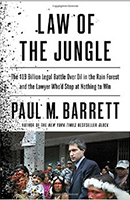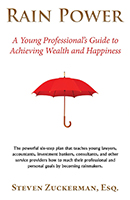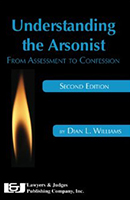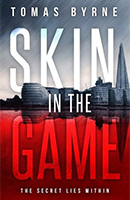 VERDICT: It’s a Keeper
VERDICT: It’s a Keeper
Law of the Jungle: The $19 Billion Legal Battle Over Oil in the Rain Forest and the Lawyer Who’d Stop at Nothing to Win
By Paul M. Barrett (New York, NY: Crown, 2014). 259 pgs. $19.26. Order, www.amazon.com.
Reviewed by Emily Kelchen
When I finished reading this book, I turned to my husband and said, “I feel like I need a shower and deserve an ethics credit.” Law of the Jungle is an in-depth look at the legal fight between an environmental crusader and “Big Oil” over the industry’s effect on the Ecuadorian people and land.
At first blush, this appears to be a typical David and Goliath tale. But Bloomberg Businessweek’s Paul M. Barrett paints a vivid portrait of the parties that quickly makes clear the difference between good and evil is not so clear cut. The tale of fraud and corruption is so artfully recounted that I had to keep reminding myself this is a true story.
Want to Review a Book?
Please request a book and writing guidelines from Wisconsin Lawyer managing editor Karlé Lester, at klester@wisbar.org or (608) 250-6127. Reviewers may keep the book reviewed. Reviews of about 500 words are due within 45 days of receiving the book. Reviews are published, space permitting, in the order received and may be edited for length and clarity.
The plaintiffs’ attorney, Steven Donziger, is a Harvard-educated media whiz who was able to gin up popular support and financing for his cause. He is familiar with Latin America because he worked there as a reporter before law school, but many of the tactics he claimed are standard in the Ecuadorian legal system would get you disbarred in the United States. The longer the case went on, the shakier his legal footing became.
Chevron, the defendant, was determined to fight into submission Donziger and the plaintiffs he represented, as it had done in so many cases before. The company, which got involved after it bought the original defendant, Texaco, knows that settling these sort of cases creates a precedent that will only encourage more cases to be filed against it in the future. Chevron mounted an aggressive defense, employing tactics that fell into the grey areas of legal ethics, but was thwarted at every turn by Donziger and the idiosyncratic Ecuadorian legal system.
If you have been following this case, you will know that this epic legal saga is still playing out. Chevron is still fighting to have the $19 billion judgment the Ecuadorian court levied against it invalidated. Donziger is fighting to regain his credibility and rekindle support for the case. The giant verdict and Donziger’s reputation took a big hit after details of the fraud pervading the case were revealed in a racketeering lawsuit Chevron brought against Donziger in U.S. federal court.
Barrett’s research is meticulous, his treatment of the parties is evenhanded, and his writing is crisp, making this an enjoyable read. Beyond that, the book offers a valuable lesson – zealous representation must be tempered by adherence to the rules of civil procedure and professional responsibility if the rule of law is to be maintained.
Emily Kelchen, U.W. 2011, is the New Jersey Civil Justice Institute’s director of public affairs.
 VERDICT: It’s a Keeper
VERDICT: It’s a Keeper
Rain Power: A Young Professional’s Guide to Achieving Wealth and Happiness
By Steven Zuckerman (Miami Beach, FL: Steven Zuckerman, 2014). 113 pgs. $11.69. Order, www.amazon.com.
Reviewed by Bill Brown
Early in this book, Steven Zuckerman writes, “Being a skilled and hardworking professional service provider is simply the price of admission. It does not guarantee wealth, job security, personal freedom, or happiness.” Rain Power is a guide for young lawyers seeking to become rainmakers. Zuckerman’s belief is that, unless you are the source of business in a law firm, you are vulnerable to layoffs and are unlikely to achieve any measure of professional success.
Rain Power details how to identify, build, and use a professional network of potential referral sources and potential clients. Zuckerman provides a six-step business development plan: 1) set goals, 2) build a brand, 3) accelerate growth,
4) define and build a network, 5) work your network, and 6) find a mentor. Along the way, Zuckerman shares his own story. He details his first mentorship relationship and stories of significant referrals he has made and received and provides the reader with practical goal-setting advice.
The book somewhat strays from its message at times. Zuckerman mentions the murder of his father several times. An entire chapter is dedicated to the practice of meditation. These portions of Rain Power appear forced and out of place.
Overall, I would recommend Rain Power to any young lawyer. The book is a quick read at 113 pages. Zuckerman is a concise writer with an easy-to-follow style. The book is not a marketing pitch for a seminar or any other business venture. It is simply a short, practical book meant to help young professionals choose a more satisfying, profitable, and meaningful career path.
Bill Brown, U.W. 2011, is an associate at Kasieta Legal Group, Madison, and concentrates in civil litigation and education law.
 VERDICT: Touchdown!
VERDICT: Touchdown!
Rupert’s Parchment: Story of the Magna Carta
By Eileen Cameron (Herndon, VA: Macot Books, 2015). 30 pgs. $15.82. Order, www.amazon.com.
Reviewed by Dianne L. Post
This beautifully illustrated children’s book tells the story of a young boy who works for a parchment maker and witnesses the revolt of the barons against the king’s overreach and the mostly peaceful resolution of that standoff by the drafting and signing of the Magna Carta, the document that began the march toward our own Bill of Rights. The author makes skillful use of action and descriptive words to craft a story any child would be drawn to and to teach children that problems can be solved with words better than with swords. The book does not designate a reading age, but a bright fourth grader could read and understand it; by eighth grade, however, it might be a bit too simplistic.
Dianne Post, U.W. 1979, is an international human rights attorney.
 VERDICT: It’s a Keeper
VERDICT: It’s a Keeper
Understanding the Arsonist: From Assessment to Confession, 2d Ed.
By Dian L. Williams (Tucson, AZ: Lawyers & Judges Publishing Co., 2014). 208 pgs. $35. Order, www.lawyersandjudges.com.
Reviewed by Jeffrey J. De La Rosa
This book fits right in with the best-practices and evidence-based-decision-making movements within the criminal justice systems. This is a great resource if you need help with an arson case or in understanding arson. The book focuses on six specific psychological profiles or types of fire starters to explain and define arson behavior, beyond the simplified Freudian theory of arson as a sexually driven act and the DSM-IV approach of arson as a mental health issue. The book looks at the personality types (for example, thought-disordered fire starter) and goals (for example, revenge fire starter) of arsonists.
The author extensively refers to research based on interviews with actual or suspected fire starters and analysis and clinical interpretations of that research. Many readers will find the research interesting to review but of only secondary usefulness (including causing a few shakes of the head – how much research time went into connecting bedwetting and urinating on fires is pretty amazing – and exclamations over how much bad research existed in past years). The book will ultimately be of much more assistance to readers looking for greater clarity in an arson case and defining a particular fire starter for purposes of case investigation and treatment and punishment.
The book, although only 214 pages, is full of data, charts, arson examples, and breakdowns of different types of arson behavior. The author does, however, acknowledge the deficiencies and gaps in arson research. Lawyers, other criminal justice professionals, and mental health professionals would benefit from it.
Jeff De La Rosa, U.W. 1999, is an attorney manager with the Wisconsin State Public Defender.
 VERDICT: Touchdown
VERDICT: Touchdown
Skin in the Game: The Secret Lies Within
By Tomas Byrne (Delta Stream Books, 2015). Novel. 471 pgs. $15.13. Order, www.amazon.com.
Reviewed by Richard H. Ebbott
Hang on as you zip through the 471 pages of Skin in the Game. Author Tomas Byrne has penned a thriller taking you from the United States to Europe through the Middle East and into Central Asia. The plots and events could be tomorrow’s headlines if the powers that be would allow them the light of day. Calling on his experience and extensive studies, Canadian lawyer and banker Tomas Byrne introduces us to protagonist Joe Hawkins. Retired from the U.S. State Department, Hawkins has accepted a seemingly pedantic post as a lecturer at Oxford University – except that his subject matter is terrorism. Partly because of Hawkins’ expertise, partly because of the activities of his younger brother, Sam, and largely through circumstances beyond his control, Hawkins becomes a pinball in an international game of power, greed, and corruption.
Byrne takes us to a scary world where the wealthy and powerful exploit natural resources and sell weapons to control and manipulate corrupt governments. We may have the idea that capitalism can nurture the natural justice we associate with democracy. Byrne says it surely leads to the opposite: the breakdown of local culture, radical reactions, and a moral void that allows, even encourages, organized crime and terror to flourish. We little people may be just collateral damage or fallout from a game that is played at a very high level. But then little people are going to be trampled when giants want to dance.
Byrne posits that an individual’s rights, even sanity, may be abrogated to protect innocent lives. A mind may need to be reprogrammed so it does not remember things harmful to the giants, even if the individual is rendered insane in the process. As the book’s subtitle tells us, “The Secret Lies Within.” Enter Dr. Kate Farrow, an MI6 psychiatrist who is experienced in extracting information from unwilling subjects. Farrow has accepted an assignment working for the fanatical
Dr. Krug, whose methods go beyond Farrow’s professional and personal limits.
We also meet the likeable Sofi Watt, who has a history with Hawkins’ brother, Sam. Watt has left a lucrative law practice in London to become an MI5 agent now on loan to the Economic Crime Command. Part of Watt’s “brief” is to investigate a merchant bank called Density Capital, whose Passage division invests in companies operating in Central Asia, the Middle East, and North Africa. While an employee of Density, Sam Hawkins found out that, “It’s no coincidence that one of the world’s largest arms producers is working with a large natural-resource multinational and seeks the assistance of the likes of Density as its agent of corruption. Arms and commodities go hand in hand. Unexploited reserves of scarce natural resources are predominately located in socially and politically unstable countries.”
Byrne says, “When we lose the ability to stand up for ourselves, it is up to a small minority of people who have the inner strength to find and expose truth in society. It goes beyond the importance of any particular message – it is the act of speaking out that is vital. The character and bravery of the speaker, the whistle blower.” Maybe you will be so brave. Me? I thoroughly enjoyed the book on a number of levels and hope Byrne writes another one.
Dick Ebbott, U.W. 1967, worked with the FBI and the Secret Service on federal criminal prosecutions when he was a Rock County ADA. He has no experience with international crime.
